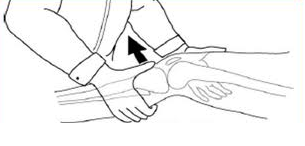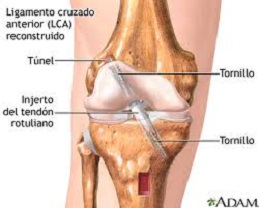http://www.aofas.org/footcaremd/treatments/Pages/Ankle-Arthroscopy.aspx
Ankle Arthroscopy
What is ankle arthroscopy? ;
Ankle arthroscopy is a minimally invasive surgical procedure that orthopaedic surgeons use to treat problems in the ankle
|
Set-up for anterior ankle arthroscopy |
|---|
joint
. Ankle arthroscopy uses a thin fiber-optic camera (arthroscope) that can magnify and transmit images of the ankle to a video screen
.
What are the goals of ankle arthroscopy?
The goals of surgery are to reduce ankle pain and improve overall function.
What is arthroscopy used for?
Arthroscopy can be used to diagnose and treat different disorders of the ankle joint. The list of problems that can be treated with this technology is constantly evolving and includes:
Ankle arthritis: Ankle fusion is a treatment option appropriate for many patients with end-stage ankle arthritis. Ankle arthroscopy offers a minimally invasive way to perform ankle fusion. Results can be equal to or better than open techniques.
Ankle fractures: Ankle arthroscopy may be used along with open techniques of fracture repair. This can help to ensure normal alignment of bone and cartilage.It may also be used during ankle fracture repair to look for cartilage injuries inside the ankle.
Ankle instability: Ligaments of the ankle can become stretched out, which can lead to a feeling that the ankle gives way. These ligaments can be tightened with surgery. Arthroscopic techniques may be an option for this problem.
Anterior ankle impingement (also referred to as athlete’s ankle or footballer’s ankle): Ankle impingement occurs when bone or soft tissue at the front of the ankle joint becomes inflamed
. Symptoms include ankle pain and swelling. This can limit the
|
Arthroscopic view of the ankle showing anterolateral impingement |
|---|
ability to bend the ankle up
. Walking uphill is often painful. Osteophytes (bone spurs) can be seen on X-ray. Arthroscopy can be used to shave away inflamed tissues and bone spurs
.
Arthrofibrosis: Scar tissue can form within the ankle. This can lead to a painful and stiff joint. This is known as arthrofibrosis. Ankle arthroscopy can be used to identify the scar tissue and remove it.
Infection: Infection the joint space cannot be treated with antibiotics alone. It often requires an urgent surgery to wash out the joint. This can be done with arthroscopy.
Loose bodies: Cartilage, bone and scar tissue can become free floating in the joint and form what is referred to as loose bodies. Loose bodies can be painful and can cause problems such as clicking and catching. Locking of the ankle joint may occur. Ankle arthroscopy can be used to find and remove the loose bodies.
Osteochondral defect (OCD): These are areas of damaged cartilage and bone in the ankle joint. OCDs are usually caused by injuries to the ankle such as fractures and sprains. Common symptoms include ankle pain and swelling.Patients may complain of catching or clicking in the ankle. The diagnosis is made with a combination of a physical exam and imaging studies. Imaging may include X-rays, MRI or CT scan. The treatment is based on the size, location and stability of the OCD. The patient’s symptoms and activity demands are also considered. Surgery often consists of scraping away the damaged cartilage and drilling small holes in the bone to promote healing. Bone grafting and cartilage transplant procedures can also be performed.
Posterior ankle impingement: This occurs when the soft tissue at the back of the ankle becomes inflamed
. Pointing the foot down can be painful. This overuse syndrome occurs commonly in dancers
. It can be associated with an extra bone called an

Lateral radiograph showing an os trigonum in the posterior ankle |
|---|
os trigonum
. The problem tissue can be removed with arthroscopy
.
Synovitis: The soft tissue lining of the ankle joint (synovial tissue) can become inflamed. This causes pain and swelling. It can be caused by injury and overuse. Inflammatory arthritis (rheumatoid arthritis) and osteoarthritis can also cause synovitis. Ankle arthroscopy can be used to surgically remove inflamed tissue that does not respond to nonsurgical treatment.
Unexplained ankle symptoms: Occasionally patients develop symptoms that cannot be explained by other diagnostic techniques. Arthroscopy provides the opportunity to look directly into the joint. The surgeon can then identify problems that may be treated with surgery.
When should I avoid ankle arthroscopy?
Elective arthroscopy is not appropriate for some patients. Patients with severe ankle arthritis may not benefit from arthroscopic “clean up” surgery. Patients with active infections or other medical problems may also not be appropriate surgical candidates.
General Details of Procedure
The surgeon marks the operative leg prior to surgery. The patient is transported to the operating room and given anesthesia. A tourniquet is commonly applied to the leg. The leg is thoroughly cleaned. The surgeon will sometimes use a device to “stretch” the ankle joint and make it easier to see.
At least two small incisions are made in the front and/or back of the ankle.These “portals” become the entry sites into the ankle for the arthroscopic camera and instruments. Sterile fluid flows into the joint to expand it and allow better visualization. The camera and instruments can be exchanged between portals to perform the surgery. After the surgery is complete, sutures are placed to close the portals. A sterile dressing is placed over the sutures. A splint or boot is often used.
What happens after the procedure?
You can expect some pain and swelling following surgery. The leg may need to be kept elevated. You may need to take oral pain medication for several days.You may be able to walk on the leg immediately, or you may need to wait several months before putting weight on the leg. This will depend on the type of surgery performed and the recommendations of your surgeon. If needed, sutures are removed one to two weeks after surgery. Your surgeon will determine when activities such as range of motion and ankle exercises are allowed. Physical therapy may also be used.
Potential Complications
There are complications that can occur with any surgery. These include the risks associated with anesthesia, infection, and bleeding or blood clots.
Potential complications specific to ankle arthroscopy include injury to nerves and blood vessels around the ankle. Numbness or tingling at the top of the foot can occur approximately 10 percent of the time. This typically resolves over time.
Frequently Asked Questions
When can I safely return to driving?
When you are able to bear weight without limitation and are no longer taking narcotic pain medication you will likely be cleared to return to driving.
When can I expect to return to work and sports?
You may be able to return work several days after surgery if you can safely complete your job duties. Most patients can expect to be out of work for at least one to two weeks. It is possible to return to high-level sports following ankle arthroscopy, but expect at least four to six weeks of recovery before getting back to such activities.
What are the outcomes of ankle arthroscopy?
Seventy to 90 percent of patients undergoing ankle arthroscopy for the most common problems achieve good or excellent results.
What are the advantages of ankle arthroscopy?
Ankle arthroscopy allows the surgeon to see inside the ankle with small incisions. This minimizes problems sometimes encountered with large incisions, such as infection and pain. The procedure can be performed as an outpatient because of its minimally invasive nature. Patients may be able to begin rehabilitation sooner, and they may be able to return to high-level activities such as sports more quickly.
The American Orthopaedic Foot & Ankle Society (AOFAS) offers information on this site as an educational service. The content of FootCareMD, including text, images and graphics, is for informational purposes only. The content is not intended to substitute for professional medical advice, diagnoses or treatments.If you need medical advice, use the "Find an Orthopaedic Foot & Ankle Surgeon" tool at the top of this page or contact your primary doctor.










